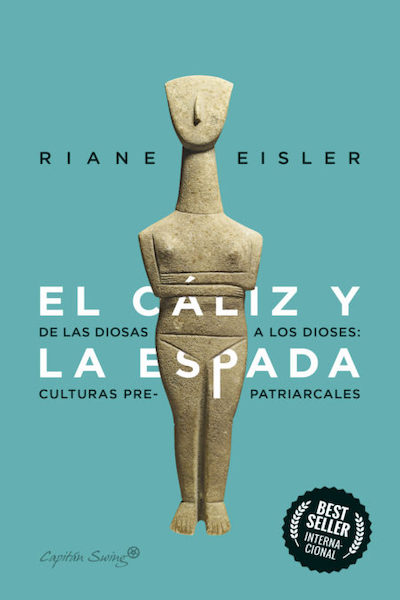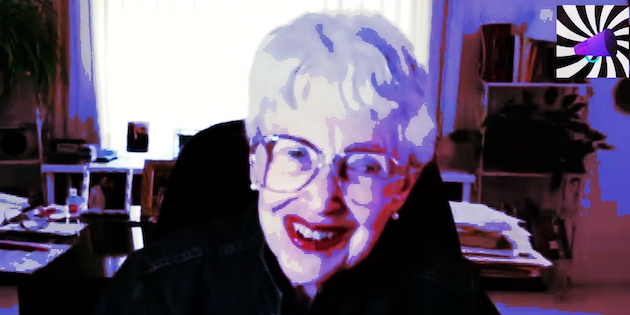July 2022
Riane Eisler spoke with Lucia Escobar for Vocería Virtual, an independent digital magazine from Chile. The article titled "Riane Eisler: la Conciencia de la Diosa, el Cuidado y la Solidaridad" or "Riane Eisler: Goddess Consciousness, Caring and Solidarity" in English, focuses on the status of women in history, in society, and in the world today.
Read the entire article in Spanish here.
Read the article translated into English below:
Two years before the fall of the Berlin Wall, the researcher Riane Eisler brought down a deeper and older wall on world politics: the dominant androcentric system, which is maintained by excluding and subjugating half of humanity: women.
The academic work The Chalice and the Blade (1987) was a bestseller, translated into 23 languages and considered the most important investigation since The Origin of Species by Charles Darwin. A recognition never given to a theory of feminism, because it was not.

Through archaeological, historical and cultural evidence of human evolution, The Chalice and The Blade revealed that the system of power and beliefs that humanity developed from its origins was gylanic, centered on feminine principles and radically different from the androcentric system that was imposed 2022 years ago. "Our past, our future" she wrote as a subtitle, indicating that knowing the real story opens the way to social and cultural transformation.
Only after the professionalization of archeology and the emergence of dating techniques such as radiocarbon did evidence begin to emerge that contradicted the academic conventions governed by prejudices, which forced discoveries to fit, time and again, the androcentric theoretical framework.
The timelines as the interpretations of the finds began to be questioned, and the presence of the Goddess in the Middle East, Asia and Europe throughout most of human history, could not be hidden.
After the emergence of science based on evidence, it took a century for women to massively access education, a privilege of aristocrats, bourgeois and men until the middle of the 20th century. Only then did women like Riane Eisler in the study of evolution or Dian Fossey in primatology have the tools to account for the falsification of our history and origins as the result of "natural human violence. "
From the Upper Paleolithic, 40,000 to 10,000 years before our era, "in cave-sanctuaries, statuettes, burials and rites are related to a belief: the source from which human life flows is the same source that originates all animal and plant life. : the great Mother Goddess or the Giver of All”.
The association of the sacred and power to the feminine principles of life and care will extend throughout the Neolithic, the evolutionary leap that occurs 10 thousand years before our era and is characterized by the birth of agriculture, which enables first cities with their art, science and technology.
"Neolithic religion - like current religious and secular ideologies - expressed the worldview of its time. The degree of difference between this view and ours is demonstrated by contrasting the Neolithic religious pantheon with the Christian one. In the Neolithic, the The head of the holy family was a woman: the great Mother, the Queen of Heaven or the Goddess in her various aspects and forms. The male members of this pantheon - her consort, brother and/or son - were also divine."
The sociocultural impact of the Goddess was explained for the first time thanks to Eisler: peaceful, caring, solidarity, equality and knowledge societies developed. Agriculture prevented hunger, health prevented disease, peace prevented death and all this was achieved with education and equality, that was the message of the Goddess and her symbols. For this reason, the superiority of feminine principles was manifested in the political, economic and religious order, in the creation of art and technology, but not in terms of domination of some over others.
Equality between men and women was followed by social equality, tombs and buildings did not show the ostentatious differences typical of the current androcratic era. Nor is war, looting and slaughter glorified.
“One of the most impressive things about Neolithic art is what is not represented. There are no images of "noble warriors" or battle scenes here. There are also no traces of "heroic conquerors" dragging their chained captives, or other evidence of slavery.
Even more, the lack of ruler/ruled, master/subject imagery, so characteristic of dominating societies, is striking in the art of this period.
All of these features were found on the island of Crete that was home to the advanced Minoan civilization. It is the only known gylanic society to survive into historical times and is believed to be Plato's Atlantis. They had writing, architecture and urban planning and a vast maritime trade, among other advances. The archaeologist who studied it for 50 years wrote:
“All life was pervaded by an ardent faith in the goddess Nature, the source of all creation and harmony. This led to a love of peace, a horror of tyranny, and a respect for the law. Even among the ruling classes personal ambition seems to have been unknown; nowhere do we find the name of an author attached to a work of art or a record of the deeds of a ruler.
"The growing wealth of the island was judiciously used to improve living conditions, which were, even by Western standards, extraordinarily 'modern'"
Although in these societies the hierarchy of women was higher and the evidence indicates that descent and inheritance were passed through the mother, they were not matriarchy because that is a term of domination, explained Riane Eisler, that in the absence of appropriate concepts defined this model as Gilania, which unites Gy and An, the Greek roots of woman and man.
“This vision of power as the 'feminine' power to feed and give, was undoubtedly not always accepted, since these were societies made up of people of flesh and blood, and not fictitious utopias. But still, it was the normative ideal, the model to be emulated by both women and men.
Eisler refers to this in the title of his work, since knowledge of the past can build the future. The Chalice and the Blade continues to give evidence of the processes to establish the patriarchal era with death and cultural falsification.
The technology of metals was used to create tools, household, ornamental and ritual objects, such as the Chalice, it was also learned by Kurgo nomads (the only "pure European race" according to Hitler) and Hebrew nomads, and transformed into objects to kill. The Sword was born. Both peoples, in successive invasions and massacres, transformed Ancient Europe, and “brought with them a ferocious, angry and misogynistic god of war”.
According to Eisler, the Greco-Roman period will be the religious and social transition. Although the main symbols of the Goddess such as Wisdom and Agriculture-Fertility are maintained because "they were still po
werful" , her hierarchy is lowered and submitted to the god-king of Olympus and warrior and murderer characteristics are added.
Socially, women are excluded from education and any form of power "the story preserved by Saint Augustine about how the women of Athens lost the right to vote at the same time that the change from matrilineal to patrilineal society occurred, indicates that the imposition of androcracy marked the end of true democracy".
All this leads to the creation of Christianity, as the ideological support of domination "in which the strongest, most brutal and violent men, the conquering warriors, nobles and kings, exercised despotic powers justified by religious ideologies of divine origin".
Eve, the woman who takes the fruit of wisdom to give it to man, as the Goddess for thousands of years, will be condemned as the origin of sin, the license to torture and kill women and followers of gylanic beliefs. The Library of Alexandria "one of the last redoubts of ancient wisdom and knowledge" was destroyed by Christian fanatics of the new male god.
"Women 's affairs" will have no intellectual or economic value and their servitude is assured in the patriarchal family, where the word of the father and husband "as of kings, is absolute law."
Eisler observes that just as the figure of Mary "Mother of God" cannot be eliminated, gylanic concepts also stubbornly reappear in Western Christian history and gain strength in the eighteenth century.
"First in the American Revolution, and then in the French Revolution, the institution of the monarchy - for many centuries the cornerstone of androcratic social organization - was threatened. In the minds of an increasing number of people, words like equality , freedom and advancement replaced words like fidelity, order and obedience".
Like Faust, the andocratic system was rejuvenated through two ideologies, capitalism and Marxism, which controlled desires for social equality and created new fanatics and justifications for wars and massacres after the end of World War II .
In the "new social order" the mass media and universities continue to reproduce the androcentric conceptual framework. As Eisler points out, "in college courses and modern popular epics like Arthur C. Clarke's 2001 (A Space Odyssey), we are taught that it has always been this way, beginning with the very first implements of rough wood and stone that, from time to time, According to this logic, they were clubs and knives to kill others"
For this reason, for Eisler, the real transformation lies in the knowledge proven with evidence, that societies of solidarity, care and respect for the other and for nature are not utopias.
“The Fall of the Roman Empire, the Dark Ages, the Plague, World Wars I and II - all the other periods of seeming chaos that we know of - fade when compared to what happened in a time about which we still know very little. : the evolutionary crossroads of our prehistory in which human society was violently transformed. Thousands of years later, when we are approaching the possibility of a second social transformation - this time a turn from a dominating society to a more advanced version of a caring society - we need to understand as well as possible this amazing stage of our lost past. For what is at stake at this second evolutionary crossroads, in which we possess the technologies for total destruction that were once attributed only to God, Eisler wrote in 1987.
After The Chalice and the Blade, Riane Eisler continued to delve into the challenge of creating gylanic societies. She founded the Center for Partnership Systems and even developed her own model of a solidarity economy, which transcends the capitalist and socialist categories, in her book, The Real Wealth of Nations: Creating a Caring Economy.
To find out her analysis in light of the latest events such as the Pandemic, the war in Ukraine and the decline in Women's Rights in the US, Riane Eisler will give an exclusive interview to Vocería Virtual this Thursday, July 28 at 8:30 p.m. through our social networks. See scheduled link on Youtube.
See also: El Cáliz y la Espada: The popularity of the Chalice and the Blade in Colombia




Leave a Reply